Questions with Answers, Solution | Geometry | Term 2 Chapter 4 | 7th Maths - Exercise 4.2 (Congruency of Triangles) | 7th Maths : Term 2 Unit 4 : Geometry
Chapter: 7th Maths : Term 2 Unit 4 : Geometry
Exercise 4.2 (Congruency of Triangles)
Exercise
4.2
1. Given that ∆ABC ≡ ∆DEF
(i) List all the corresponding congruent sides
Corresponding sides: AB,
DE; BC, EF; AC, DF.
(ii) List all the corresponding congruent angles.
Corresponding angles: ∠ABC, ∠DEF; ∠BCA, ∠EFD; ∠CAB, ∠FDE.
2. If the
given two triangles are congruent, then identify all the corresponding sides and
also write the congruent angles.
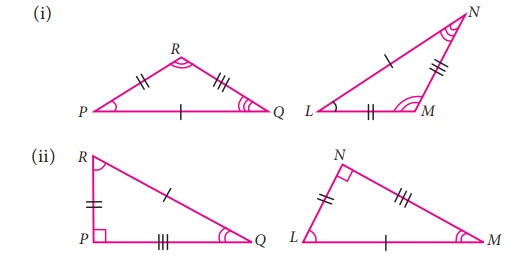
Solution:
(i) Corresponding sides:
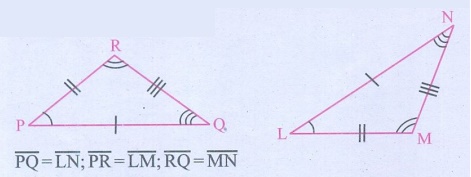
∠RPQ = ∠NLM; ∠PQR = ∠LNM; ∠PRQ = ∠LMN;
(ii) Determine congruent angles

∠PQR=∠LMN; ∠QRP = ∠MLN; ∠RPQ = ∠LNM
3.
If the given triangles ∆ABC and ∆EFG are congruent, determine whether
the given pair of sides and angles are corresponding sides or corresponding angles
or not.
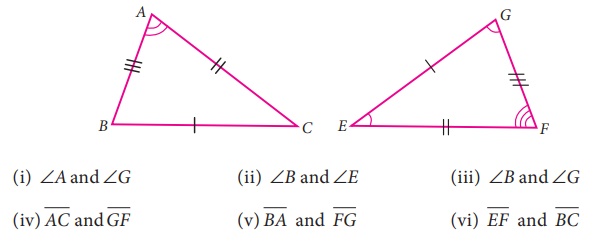
Solution:
(i) ∠A and ∠G
Not corresponding angles
(ii) ∠B and ∠E
Not corresponding angles
(iii) ∠B and ∠G
corresponding angles
(iv) AC̅ and GF
Not corresponding angles
(v) BA̅ and FG
corresponding angles
(vi) EF̅ and BC
Not corresponding angles
4. State whether the two triangles are congruent or not. Justify your answer.

Solution:
(i) By SAS criterion the two triangles are congruent
(ii) By SSS criterion the two triangles are congruent
(iii) By AAA criterion the two triangles are congruent
(iv) By RHS criterion the two triangles are congruent
(v) The two triangles are congruent by SSS (or) RHS (or) SAS.
5. To conclude the congruency of triangles, mark the required information in the following figures with reference to the given congruency criterion.
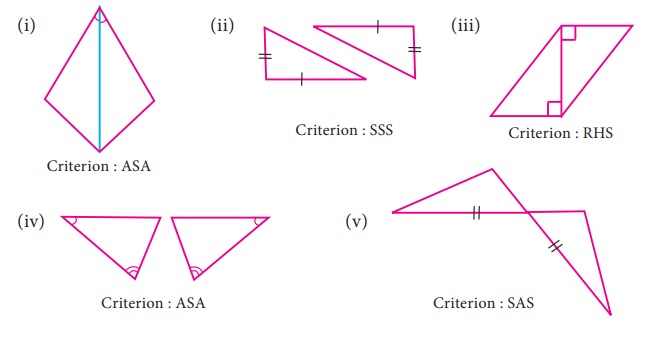
Solution:
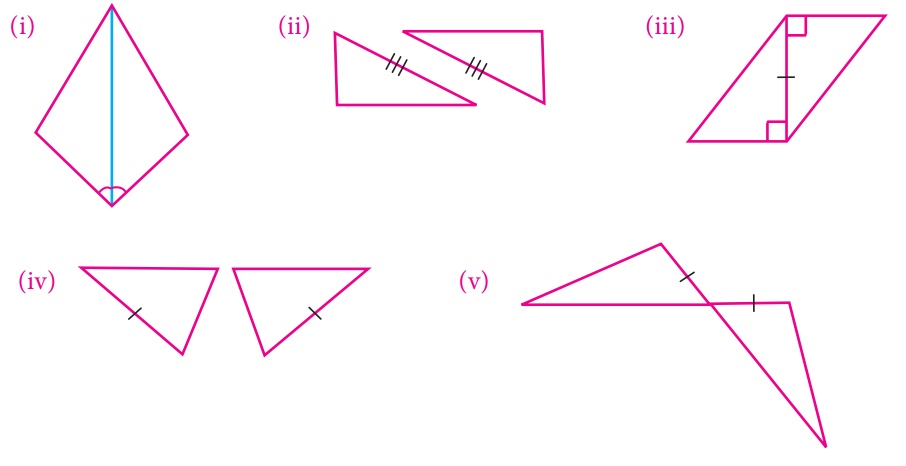
6.
For each pair of triangles state the criterion that can be used to determine the
congruency?

Answer:
(i) SSS criterion
(ii) ASA criterion
(iii) RHS criterion
(iv) ASA criterion
(v) ASA criterion
(vi) SAS criterion
7. I. Construct a triangle XYZ
with the given conditions.
(i) XY = 6.4
cm, ZY = 7.7 cm and XZ = 5 cm
Solution:
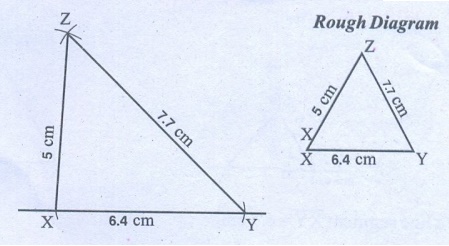
Steps:
1. Draw a line segment X̅ Ȳ = 6.4 cm.
2. With X as centre, draw an arc of radius 5 cm above the line
XY.
3. With Y as centre, draw another arc of radius 7.7 cm to intersect
the previous arc at Z.
4. Join XZ and YZ.
Now XYZ is the
required triangle.
(ii) An equilateral triangle of side
7.5 cm

Steps:
1. Draw a line segment X̅Ȳ = 7.5 cm.
2. With X as centre, draw an arc of radius 7.5 cm above the line
XY another.
3. With Y as centre draw another arc of radius 7.5 cm to
interest the previous arc at Z.
4. Join XZ and YZ.
Now XYZ is the
required triangle.
(iii) An isosceles triangle with equal
sides 4.6 cm and third side 6.5 cm

Steps:
1. Draw a line segment X̅ Ȳ = 6.5 cm.
2. With X as centre, draw an arc of radius 4.6 cm.
3. With Y as centre draw another arc of radius 4.6 cm to
intersect the previous arc at Z.
4. Join XZ and YZ.
Now XYZ is the
required triangle.
II. Construct a triangle ABC with given
conditions.
(i) AB = 7
cm, AC = 6.5 cm and ∠
A = 120°.
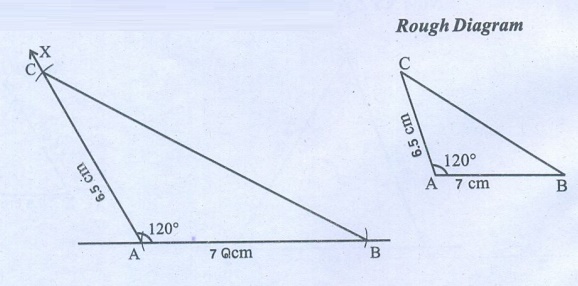
Steps:
1. Draw a line segment AB = 7cm.
2. At A, draw a ray AX making an angle of 120° with AB.
3. With A as centre, draw an arc of radius 6.5 cm to cut the ray
AX at C.
4. Join BC.
Now ABC is the
required triangle.
(ii) BC = 8
cm, AC = 6 cm and ∠
C = 40°.
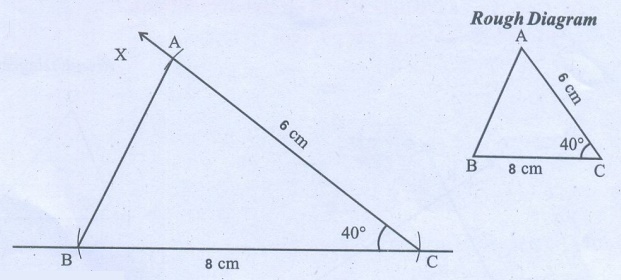
Steps:
1. Draw a line segment B̅C̅ = 8 cm.
2. At C draw a ray CX making an angle of radius.
3. With C as centre draw an arc of radius 6 cm.
4. Join AB.
Now ABC is the
required triangle,
(iii)
An isosceles obtuse triangle with equal sides 5 cm

Steps:
1. Draw a line segment A̅B̅ = 5 cm.
2. At B, draw a ray BX making an angle of 110° with AB.
3. With B as centre, draw an arc of radius 5 cm to cut the ray
BX at C.
4. Join AC.
Now ABC is the
required triangle.
III.
Construct a triangle PQR with given conditions.
(i) ∠
P = 60°, ∠
R = 35° and PR = 7.8 cm
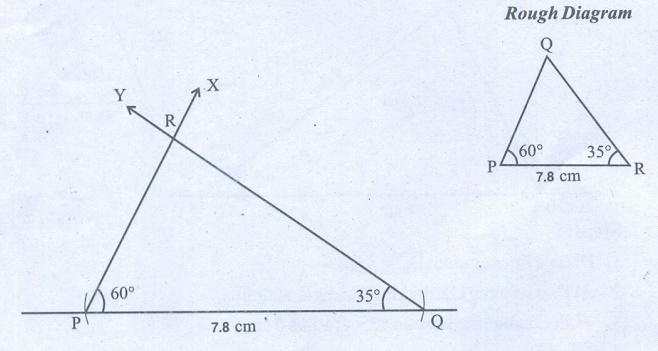
Steps:
1. Draw a line segment P̅R̅ = 7.8 cm.
2. At P, draw a ray PX making an angle of 60° with PR.
3. At R, draw another ray RY making an angle of 35° with LM. It
intersects the previous ray at Q.
Now PQR is the
required triangle.
(ii) ∠
P = 115°, ∠
Q = 40° and PQ = 6 cm
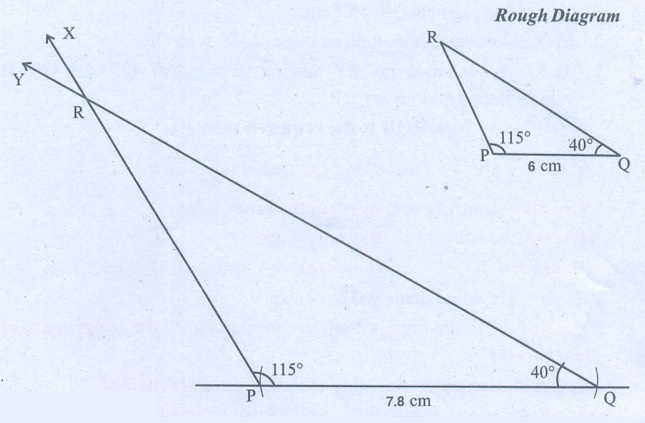
Steps:
1. Draw a line segment P̅Q̅ = 6 cm.
2. At P, draw a ray PX making an angle of 115° with PQ.
3. At Q, draw another ray QY making an angle of 40° with PQ. It
intersects the previous ray at R.
Now PQR is the
required triangle.
(iii) ∠ Q = 90°, ∠ R = 42° and QR = 5.5 cm

Steps:
1. Draw a line segment QR = 5.5 cm.
2. At Q, draw a ray QX making an angle of 90° with QR.
3. At R, draw another ray RY making an angle of 42° with QR. It
intersects the previous ray at R
Now PQR is the
required triangle.
Objective type questions
8.
If two plane figures are congruent then they have
(i) same size
(ii) same shape
(iii) same angle
(iv) same shape and same size
Answer : (iv) same shape and same size
9.
Which of the following methods are used to check the congruence of plane figures?
(i) translation method
(ii) superposition method
(iii) substitution method
(iv) transposition method
Answer : (ii) superposition method
10.
Which of the following rule is not sufficient to verify the congruency of two triangles.
(i) SSS rule
(ii) SAS rule
(iii) SSA rule
(iv) ASA rule
Answer : (iii) SSA rule
11.
Two students drew a line segment each. What is the condition for them to be congruent?
(i) They should be drawn with a scale.
(ii) They should be drawn on the same
sheet of paper.
(iii) They should have different lengths.
(iv) They should have the same length.
Answer : (iv) They should have the same length
12.
In the given figure, AD=CD and AB=CB. Identify the other three pairs that are equal.
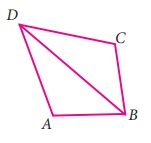
(i) ∠ADB = ∠CDB, ∠ABD = ∠CBD, BD = BD
(ii) AD=AB, DC=CB, BD=BD
(iii) AB=CD, AD=BC, BD=BD
(iv) ∠ADB = ∠CDB, ∠ABD = ∠CBD, ∠DAB = ∠DBC
Answer: (i) ∠ADB = ∠CDB, ∠ABD = ∠CBD, ∠DAB = ∠DCB
13.
In ∆ABC and ∆PQR, ∠ A=50°=
∠ P,
PQ=AB, and PR=AC. By which property ∆ABC and ∆PQR are congruent?
(i) SSS property
(ii) SAS property
(iii) ASA property
(iv) RHS property
Answer : (ii) SAS property
ANSWERS:
Exercise 4.2
1. Corresponding sides
: AB, DE; BC, EF; AC, DF
Corresponding angles :
∠ ABC, ∠ DEF; ∠ BCA, ∠ EFD; ∠ CAB, ∠ FDE
2. (i) 
∠RPQ = ∠NLM; ∠PQR = ∠LNM; ∠PRQ = ∠LMN
(ii) 
∠PQR = ∠LMN; ∠QRP = ∠MLN; ∠RPQ = ∠LNM
3. (i) Not corresponding
angles (ii) Not corresponding angles
(iii) corresponding angles (iv) Not corresponding sides (v) corresponding sides (vi) Not
corresponding sides
4. (i) congruent
triangles by SAS (ii) congruent triangles by SSS (iii) congruent triangles by AAA (iv)
congruent triangles by RHS (v) congruent
triangles by SSS (or) RHS (or) SAS
5. 
6. (i) SSS (ii) ASA
(iii) RHS (iv) ASA (v) ASA (vi) SAS
Objective type questions
8. (iv) same shape and
same size
9. (ii) superposition
method
10. (iii) SSA rule
11. (iv) They should
have the same length
12. (i) ∠ADB = ∠CDB; ∠ABD = ∠CBD; BD = BD
13. (ii) SAS property
Related Topics